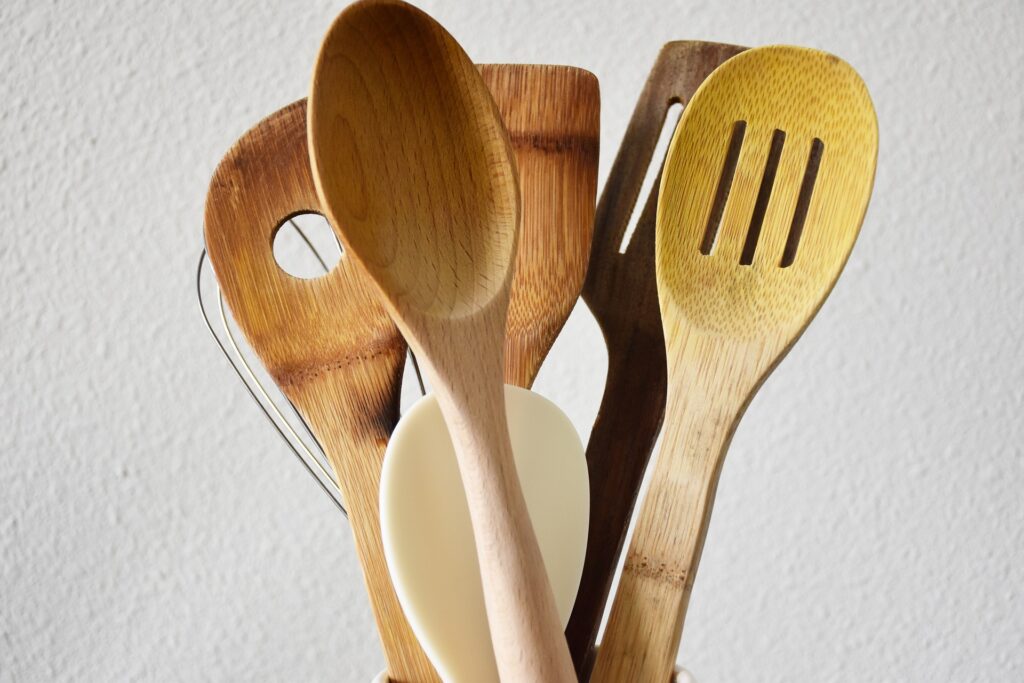If you are just starting with preserving, or are looking for a better and safer way to do things, long-handled wooden spoons might be the answer.
Unlike metal spoons, which can cause bruising and discolouration in your preserves, and leave scratches on your preserving pan, wooden spoons are gentler on the fruits, vegetables and pan that you are working with. Importantly, they give you more distance from the hot preserves, which is helpful when you are dealing with boiling syrup or jam.

Furthermore, wooden spoons are affordable and easy to find at most kitchen stores, online or in homeware departments of supermarkets. So if you’re ready to try your hand at making preserves, consider a long-handled wooden spoon as part of your toolkit!
What is the role of the long-handled wooden spoon?
Wooden spoons have been a staple kitchen utensil for much of the history of cooking. They then started to become less popular in the 1990s because of bacteria-phobia associated with their use, and so were swiftly replaced by plastics and stainless steel spoons. However, recent evidence suggests that providing that the integrity of the spoon surface is maintained, it is ok to use wooden spoons safely in your kitchen once again and that they may even bring some benefits to the cooking process.
A wooden long-handled spoon is a kitchen utensil with a long handle often with a wide, flat bowl. It is used for stirring, tasting, and portioning food.
Advantages of Wooden Spoons
- It does not conduct heat as easily as metal does. This is beneficial when cooking or preserving because it prevents the handle from becoming too hot to touch.
- Wooden spoons are less likely to scratch cookware. They’re perfect for stirring foods that require a lot of movement and won’t scratch the finish off nonstick surfaces or leave scars on copper pans.
- You can avoid “shocking” temperature-sensitive mixtures and prevent crystallization. Which is what happens when a cold metal spoon is used.
- They are relatively heat resistant, which means they can withstand being placed in hot syrups without melting.
- They also don’t release chemicals into hot food like some plastics can. (this can however depend on how/if your wooden spoon has been finished, so keep this in mind).
- They are non-reactive. Some metals react with acidic foods (their protective coating can be damaged making them prone to rusting), like tomato sauces and lemon curds, but wooden spoons do not suffer this effect.
Limitations of Wooden Spoons:
- They are not as durable as metal and can break or warp if not properly cared for.
- They also require more frequent replacement than metal spoons.
Overall, wooden long-handled spoons have both pros and cons, but they remain a popular choice for cooking and preserving.
Some Tips about Caring for your Wooden Kitchen Utensils:
- Hand wash them with hot water and mild detergent. Next, spray them with a sanitiser, rinse them, and then let them dry completely. Always air dry them to protect against bacteria transferral from a hand towel.
- Although wooden items can go in the dishwasher, it’s not recommended because the high temperatures could dry them out. The best way to clean a spoon is by washing it with soap and water. This will eliminate any bacteria that may be on the surface of the spoon.
- You can also disinfect your wood spoons by using a diluted bleach solution, which is what restaurants do. However, at home, this step isn’t necessary unless you want to go above and beyond.
- Although wooden spoons are tough, if you use them repeatedly for hot dishes or put them in the dishwasher too often, they may crack. The dishwasher drying cycle is especially harmful to wooden spoons. When food gets trapped in these nooks and crannies, it provides the perfect environment for bacteria to grow. So, if your spoons are starting to show these signs of damage, it’s time to get new ones.
- If the spoon starts to look dry or “fuzzy” from use or it looks dry, simply rub it down with food-grade mineral oil. After letting the spoon sit in the oil overnight, wipe away any leftover residue and wash it with soap and water. The spoon will now be ready to use again.
Types of wooden spoons
Hard, dense wooden spoons are perfect for cooking. Maple wood or olive-hickory wood is quite popular, as is teak, bamboo and beechwood. There has been quite a Renaissance happening within today’s woodworking industry where artists create beautiful handmade pieces especially designed by chefs who want more than just basic plasticware at their disposal.
You can buy high-quality wooden spoons at kitchen supply stores/departments, online or from home goods retailers. By investing in high-quality wooden spoons, you can not only protect your investment but also create family heirlooms.
And if you’re still not convinced about using wooden spoons, don’t worry! Silicone utensils are a great second-string option. Like wooden spoons, they can handle thick hot dishes without much issue, they won’t melt or absorb flavours either. I am lucky to have both a wooden spoon and a silicone one, and I love both! It depends on my mood and what I am making for which one I will use, although I have been known to somehow use both when lost in creating something tasty.
Making homemade preserves is a wonderful way to enjoy fruits and vegetables. A long-handled wooden spoon can support your creative efforts by making the process smoother and more enjoyable. Find a spoon that is versatile, comfortable and safe, that suits your needs and preferences, and that helps you to enjoy the process of making.